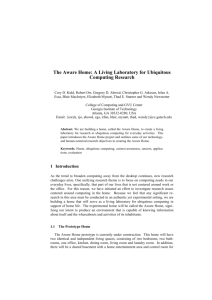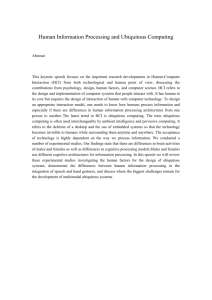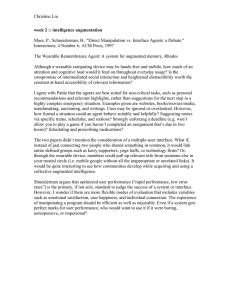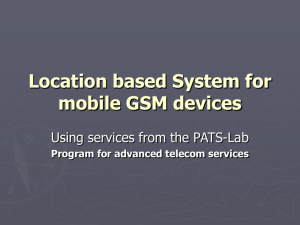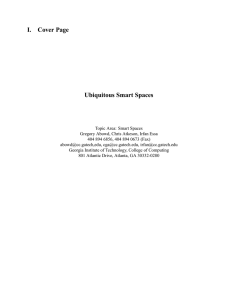The Aware Home: A Living Laboratory for Ubiquitous Computing Research
advertisement
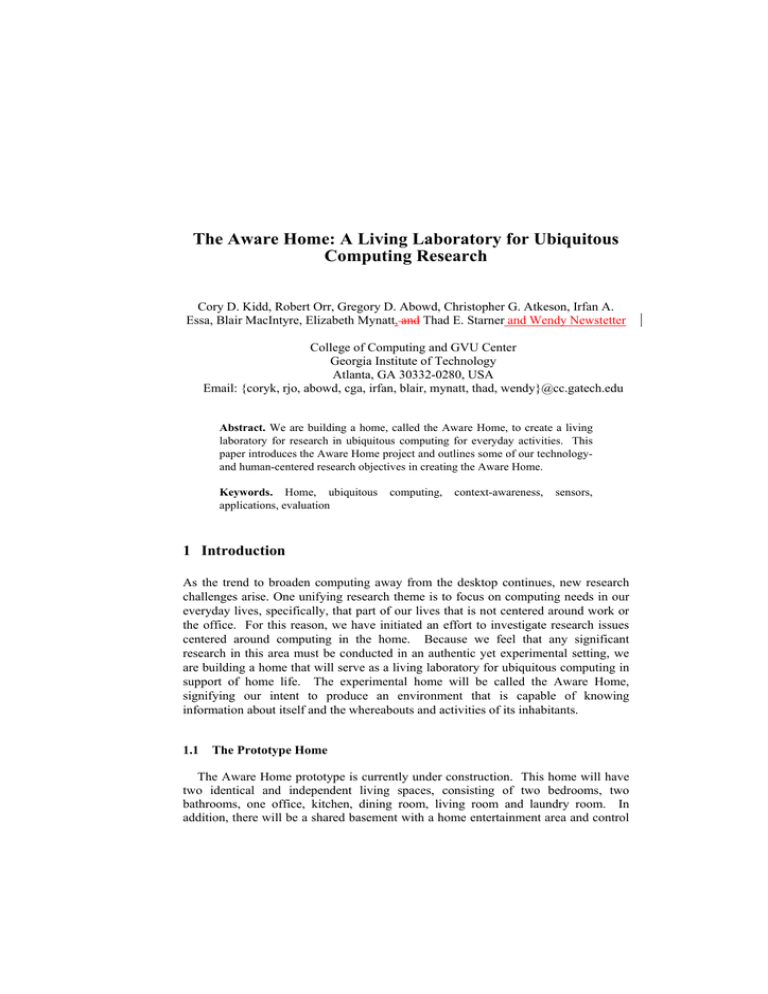
The Aware Home: A Living Laboratory for Ubiquitous
Computing Research
Cory D. Kidd, Robert Orr, Gregory D. Abowd, Christopher G. Atkeson, Irfan A.
Essa, Blair MacIntyre, Elizabeth Mynatt, and Thad E. Starner and Wendy Newstetter
College of Computing and GVU Center
Georgia Institute of Technology
Atlanta, GA 30332-0280, USA
Email: {coryk, rjo, abowd, cga, irfan, blair, mynatt, thad, wendy}@cc.gatech.edu
Abstract. We are building a home, called the Aware Home, to create a living
laboratory for research in ubiquitous computing for everyday activities. This
paper introduces the Aware Home project and outlines some of our technologyand human-centered research objectives in creating the Aware Home.
Keywords. Home, ubiquitous
applications, evaluation
computing,
context-awareness,
sensors,
1 Introduction
As the trend to broaden computing away from the desktop continues, new research
challenges arise. One unifying research theme is to focus on computing needs in our
everyday lives, specifically, that part of our lives that is not centered around work or
the office. For this reason, we have initiated an effort to investigate research issues
centered around computing in the home. Because we feel that any significant
research in this area must be conducted in an authentic yet experimental setting, we
are building a home that will serve as a living laboratory for ubiquitous computing in
support of home life. The experimental home will be called the Aware Home,
signifying our intent to produce an environment that is capable of knowing
information about itself and the whereabouts and activities of its inhabitants.
1.1
The Prototype Home
The Aware Home prototype is currently under construction. This home will have
two identical and independent living spaces, consisting of two bedrooms, two
bathrooms, one office, kitchen, dining room, living room and laundry room. In
addition, there will be a shared basement with a home entertainment area and control
2
room for centralized computing services. We expect construction of the house to be
complete by the end of the 1999 calendar year.
The reasons for building two independent living spaces are to allow for controlled
experiments with technology and to allow inhabitants to live on one floor while
prototyping or providing demonstrations on the other floor. We anticipate that the
initial occupants will be students involved in the research project living in only one
floor of the house. A longer-term goal is to have both floors occupied by a family or
elderly occupants, as these are the targeted groups of our research. These occupants
will give more realistic feedback on the performance of systems within the house.
We anticipate that the house will not be ready for us to occupy for nearly nine
months from the date of this writing. We are moving ahead with the research project
in this interim period. In order to test some of the systems that we plan to use in the
house, we have constructed a prototype room in our lab. The room was constructed
using standard house construction techniques to resemble the actual house as closely
as possible. We expect to implement some systems immediately to test their
effectiveness in the house. These systems include human position tracking through
ultrasonic sensors, RF technology and video, recognition through floor sensors and
vision techniques.
Fig. 1, 2. First and second floor plan, front elevation of house
1.2
Our background
Rather than provide an exhaustive survey on home automation, intelligent
environments and other related work,1 we provide a brief summary of our research
backgrounds and relevant work we have conducted at Georgia Tech on living
laboratories for ubiquitous computing research and computing in the home.
The research interests assembled to work on this project cover a wide spectrum.
These interests include HCI, ubiquitous computing, ethnography, machine learning,
computational perception, augmented reality, wearable computing, wireless
1
Interested readers can explore a Web-based collection of this related work at
http://www.cc.gatech.edu/fce/seminar/fa98-info/smart_homes.html.
3
networking, security, distributed systems, software engineering and sensor
technology. In this paper, we will outline some of the specific research goals for the
Aware Home project that cover this wider spectrum of research interests.
One of the reasons we are committed to this experimental model of ubiquitous
computing research, in which a living laboratory is created for experimentation within
some specific domain, is that it has proven a very successful model for us in a
different domain. Since July 1995, we have conducted research on ubiquitous
computing in support of education through the Classroom 2000 project, as described
by Abowd (1999).2 One of the main goals of that project has been to instrument an
actual classroom environment to enable the recording of live lectures. This captured
experience is then made accessible to students and teachers afterwards. Extensive
experience using this system has greatly informed our understanding of the general
ubiquitous computing problem of automated support for capture and access to live
experiences. This deep understanding would not have been possible had we not
gained authentic experience with many different users over an extended period of
time.
We have been interested in ubiquitous computing as it applies to the home for a
number of years. Our earlier efforts were covered in the Domisilica project, an
attempt to build a bridge between the physical home environment and the electronic
world of a virtual community or MUD environment (Mankoff et al., 1998).
In the rest of this paper, we will present our research agenda in two parts. The first
part will deal with research topics focussed on technology in the Aware Home. In
this part we introduce the types of technologies that we plan to use in our research.
The second part will deal with more human-centered research issues. It is here that
we discuss the possible applications that this environment could have in the future. In
our final section, we discuss the social implications that we foresee in this research
and address possible difficulties that will have to be overcome in this research.
2 Technology-Centered Research Agenda
Our research in the Aware Home covers many different areas. In this section, we
provide a summary of some technological themes being investigated. We will not
directly address some of the networking and distributed computing themes here. This
research is being conducted by other Georgia Tech researchers to provide high
bandwidth wireless and wired networking throughout the home and to provide
appropriate security mechanisms for the middleware within the complex high
performance computing environment we are building. Instead, in the next section we
discuss application and evaluation research themes.
2
Information on Classroom 2000 can be found at http://www.cc.gatech.edu/fce/c2000.
4
2.1
Context Awareness and Ubiquitous Sensing
Humans, in general, are quite successful at communicating complex ideas to each
other, due in part to an implicit shared understanding known as context. When
humans interact with computers, there is very little shared understanding or context.
However, it is becoming increasingly possible to build sensors that can help a
computational environment to interpret and begin to understand the contextual cues of
its occupants. In augmented environments, such as the Aware Home, we need to
provide the capability for computational services to take advantage of these soon-tobe ubiquitous sensing capabilities. For example, we have built vision-based sensors
to track multiple individuals in an environment (Stillman et al., 1999) and we are
trying to use similar signal processing techniques to build a smart floor interface that
can identify and track people walking across a large area. There are many compelling
applications for these sensing technologies throughout a home, such as support for the
elderly or finding lost objects, or in specialized spaces within the home, such as the
front door or the kitchen.
However, progress in the sensing technologies needs to be matched by progress in
supporting the rapid development of applications that use sensed information. These
applications are what we call context-aware applications, and we are building a
software infrastructure to assist in their rapid development (Salber et al., 1999). To
date, the context-aware development infrastructure has been applied to controlled
situations in an office environment and we see the Aware Home as a very valuable
resource for exercising much of the capabilities we want to provide in a robust and
programmable software infrastructure.
2.2
Individual Interaction with the Home
One interesting direction of this work occurs when we consider sensing on the
body, as is done in wearable computing, in conjunction with sensing off the body, as
is typical in an instrumented environment. In this environment, human-home
symbioses becomes important as a means to provide as seamless interaction as
possible with the home. Wearable computers and intelligent environments allow the
delivery of convenient, personalized information and entertainment services at almost
any time and in any context. However, there is very little work on how wearable
computing and any computing infrastructure attached to the home environment
should interact together on behalf of a user. By learning about users' habits and
behavior, embedded systems in the home may perform complex, seemingly intelligent
tasks automatically. Part of the technological and social challenge is determining
where to put various interaction and sensor technologies for maximum benefit.
The Aware Home infrastructure is an excellent chance to obtain general
information about a user while at home, and a wearable computer can gather data
wherever the user may go. The home can contain a large amount of computation and
infrastructure for sensing at a distance, while a wearable has the advantage of
immediate and intimate contact with the user. The data gathered on the wearable
might then be filtered and released to the environmental infrastructure as appropriate.
On the other hand, the wearable may draw on the house's data resources to cache
5
important information for the mobile user when away from the house. Thus, an
automated wireless collaboration between the platforms seems appropriate, with the
user placing limits on the type and level of information transferred between his
personal and environmental infrastructure. We will develop such infrastructure
interactions and explore some of the technical and social benefits.
2.3
The Smart Floor
In ubiquitous computing, knowing who is where and what they are doing is central to
enabling intelligent behavior. In the Smart Floor project, we are addressing the who
and where aspects of this problem: we have created a system to identify and locate a
person based solely on his or her footsteps3. In this system, we will place ten
strategically sized and located force-sensitive load tiles throughout the Aware Home
to gather footstep data from occupants. The tiles are flush with the floor and consist of
a metal plate supported by four industrial load cells; the data we gather from these
tiles are known as ground reaction force (GRF) profiles. We have gathered sets of
training data to create footstep models for each person; we then compare each new
GRF profile against these models and search for the best match. We have used two
techniques to create models for each user: Hidden Markov Models (HMMs), and
simple feature-vector averaging. Work similar to our HMM approach was described
recently by Addlesee, et al. (1997). For a reasonably sized user population (on the
order of 10 people), the GRF profiles are unique enough to correctly identify the user
over 90% of the time. We are currently characterizing the system more fully,
including examining the effect different shoes have on GRF profiles, and comparing
the Smart Floor to identification technologies such as face recognition. We are also
investigating the relevance and robustness of the particular features chosen for our
feature-vector models, and are studying other methods for creating and evaluating the
user models, such as neural networks.
As mentioned above, we will strategically size and locate our Smart Floor tiles
throughout the Aware Home. In addition to the tiles, we are exploring other
technologies to track users more finely throughout the house; we are evaluating
systems based on grids of piezoelectric wires, grids of deformation sensitive optical
fibers, and networks of vibration sensors attached to the underside of the flooring. In
this tracking system, we will establish identity and a location landmark using the
Smart Floor tiles and track the movement of users with the finer grained system.
2.4
Finding Lost Objects
One of the applications of the tracking and sensing technologies in the Aware Home
will be a system for finding Frequently Lost Objects (FLOs), such as keys, wallets,
glasses, and remote controls. The system will use small radio-frequency tags attached
3
More information on the Smart Floor
http://www.cc.gatech.edu/fce/smartfloor/index.html.
project
can
be
obtained
at
6
to each object the user would like to track and a long-range indoor positioning system
to track these objects (Werb and Lanzl, 1998). The user will interact with the system
via LCD touch panels placed strategically throughout the house (for example, by the
front door). The system will guide the user to the lost object using spatialized audio
cues (e.g., “Your keys are in the bedroom.”). While we hope that the FLO system
will be able to keep track of objects 100% of the time, we know that these
expectations are not realistic; another person may walk off with the keys, or the
batteries in the tag may fail. In these exceptions, the other tracking technologies in
the house, such as the Smart Floor, can assist in locating the objects. For example, if
the keys were last seen with Jane at the front door at 8:30am, the system can inform
the user of these facts and the user can conclude that Jane accidentally took the keys
with her to work.
3 Human-Centered Research Agenda
An important question to address in the Aware Home is what purpose does the
technology serve from the occupants’ perspective. We have suggested that we intend
to support everyday activities, but that is too vague. Our initial studies on home life
have revealed several research topics. The first presented here is support for the
elderly and the second is the need for qualitative studies of home living. We conclude
this section with an example application used for finding lost objects in the home.
3.1
Specific application: Support for the elderly
There can be no denying that the U.S. population is aging. As the baby boom
approaches late middle age it seems clear that this maturing mass of humanity will
impact this country both financially and emotionally. One question concerns how to
care for a population that lives many years longer than any preceding generation. A
part of this question involves where one lives as one ages. Assisting a person to
remain in familiar surroundings as they age not only improves the quality of their life
but also increases the length of that life. But the increased mobility stemming from
the industrial revolution has forever changed American society. People no longer live
in the same community all their lives. Aging parents no longer live close to their adult
children. The current practice of institutionalizing elderly people into assistive living
centers is expensive and often an unsatisfactory experience for all involved.
As people get older and find it more difficult to live on their own, they are often
forced to move out of their homes, though they do not require any type of constant
physical assistance. This is done not only to provide peace of mind to their family
members, but also to themselves. Moving out to some form of assisted living provides
the security of frequent monitoring and the availability of medical assistance in the
event of an emergency. If these people were able to keep that "peace of mind" while
still living in their own homes, they would not be forced away from the familiarity
and friends to which they are accustomed. The goal of this project is to design a
system that provides a type of monitoring currently supported by an assisted living
7
center for those individuals that do not demand frequent medical help or services that
could only be provided by another person.
In our preliminary investigations we have identified three areas for interface design
and sensing technology research.4 First, we want to support social connections
between elder parents and their adult children promoting peace of mind for family
members. These persistent connections will convey activity in the respective homes
as well as trends over time. Second, we hope to support "everyday cognition" by
augmenting those aspects of memory that decline with age and planning capabilities
of elder residents. Third, we also plan to sense and identify potential crisis situations
so that appropriate outside services can be contacted as needed.
3.2
Evaluation and Social Issues
As we explained earlier, the reason we are building the Aware Home with two
independent living areas is to allow at least one region of the home to be occupied at
all times. Our experience in Classroom 2000 has shown the value of everyday use of
a ubiquitous computing environment, both for informing the iterative design cycle
and for understanding how technology and people co-evolve.
An important issue that must be addressed in the context of this project is the
consideration of privacy. The home is constantly monitoring the occupants’
whereabouts and activities, using audio and video observation methods, and even
tracking its inhabitants’ medical conditions. There is a clear need to give the
occupants knowledge and control of the distribution of this information. This is a
concern that we expect to become more prominent as we develop the systems that
will be collecting various types of sensitive information. One method that we may use
for insuring the privacy of an individual’s information is to store personal information
on a wearable computer and allowing access to be controlled from there. Other
programmatic security mechanisms are the direct concern of distributed computing
researchers involved in the project.
4 Future Challenges
4.1
Qualitative understanding of everyday home life
Designing the next generation of applications for homes is different from designing
for offices. In offices, time and how it can be used is determined by the rhythms and
culture of the organization. Movement is restricted and often monitored. Tasks and
activities are circumscribed and determined by the organization. Work is generally
couched in terms of productivity, efficiency and profit, emblems of Tayloristic
4
Further information on the Support for Aging in Place project can be found at
http://jrowan.cc.gt.atl.ga.us:8080/JimzMondoSwiki.62.
8
notions of work. But what are the frameworks that guide activities at home? Can we
apply such notions as productivity and efficiency or are there home-based concepts
that guide the way people use space and existing artifacts? There we are free to use
time as we wish, to undertake the kinds of activities that we like, to come and go as
we please, and use resources as we see fit. At home we are free to choose how space
and time are structured, what activities are undertaken and who is involved. For these
reasons, homes are what we call “free choice” environments. Because designing for
such environments is challenging, it is critical that we develop methodologies that
ensure that the latest technological advances are being funneled into useful
applications. This thread of research will apply more qualitative techniques for
uncovering applications for technology in the home.
Using qualitative techniques, one specific activity we will attempt to understand
deeply is how people lose and find objects around the home. This study will be used
to support our Frequently Lost Objects project mentioned above. We will use
ethnographic techniques to study what people lose frequently, why these things
become lost, how people go about finding these objects, and how other people in the
household may assist in finding what has been lost. While we have already outlined a
technical solution to the problem of finding lost objects in the Aware Home, we are
not irrevocably committed to this solution and we hope that our qualitative study of
this problem can help to direct modifications or our existing system or help inform the
design of another solution altogether. We also hope to use the relationships with the
families who take part in this narrow study as a jumping-off point for additional
broader studies of home life.
5 Acknowledgements
We would like to acknowledge the support of the Georgia Tech Broadband
Telecommunications Center, and specifically its director, Dr. John Limb, for the
initiation of the Aware Home project. The Aware Home is being initially funded
through the State of Georgia Research Alliance. Further information on the project
can be found at http://www.cc.gatech.edu/fce/house.
6 References
1. Abowd, G. D. (1999). Classroom 2000: An Experiment with the Instrumentation of a Living
Educational Environment. IBM Systems Journal. Special issue on pervasive computing. To
appear.
2. Addlesee, M.D., A. Jones, F. Livesey, and F. Samaria. "ORL Active Floor." IEEE
Personal Communications, Vol.4, No.5, October 1997, pp.35-41. IEEE, Piscataway, NJ,
USA.
3. Mankoff, J., J. Somers and G. D. Abowd (1998). Bringing People and Places Together with
Dual Augmentation. In the proceedings of Collaborative Virtual Environments – CVE’98,
Manchester, England, June, pp. 81-86.
Also available as a PDF document at
http://www.cc.gatech.edu/fce/publications/CVE.pdf.
9
4. Salber, D., A. Dey and G. D. Abowd (1999). The Context Toolkit: Aiding the Development
of Context-Enabled Applications. In proceedings of CHI'99, pp. 434-441. Pittsburgh, PA,
May 15-20.
5. Stillman, S. R. Tanawongsuwan, and I. Essa (1999). A System for Tracking and
Recognizing Multiple People with Multiple Cameras In proceedings of The Second
International Conference on Audio- and Video-Based Biometric Person Authentication –
AVBPA’99, Washington D.C., March 22-23.
6. Werb, J., and Lanzl, C. Designing a positioning system for finding things and people
indoors. IEEE Spectrum 35, 9 (September 1998), 71-78.
